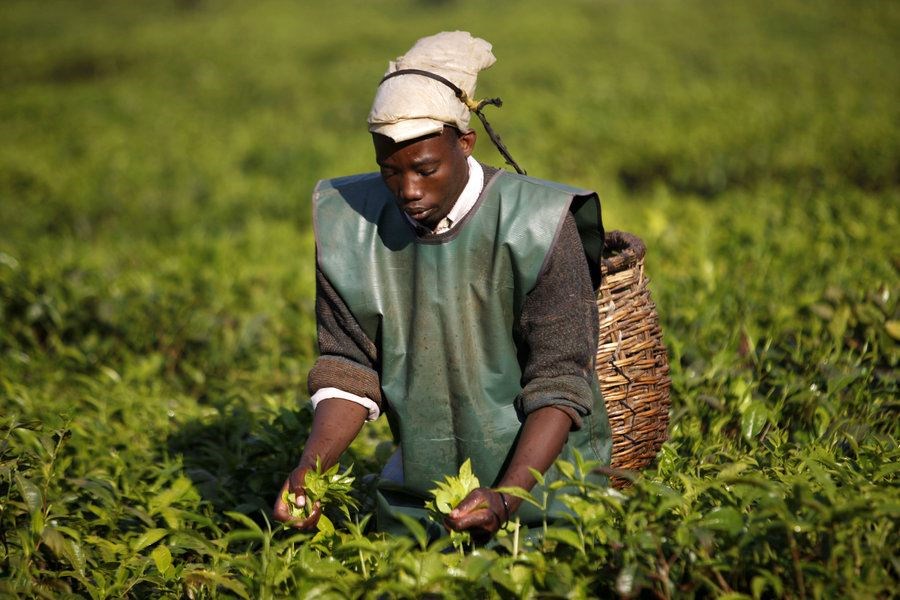Reprinted with permission from The Christian Science Monitor
In the nearly 25 years following its genocide, the East African nation has emerged as a leader in the Green Revolution that is lifting millions of people out of poverty by providing farmers with resources and training, and allowing women to inherit land.
Cedric Habiyaremye’s mission to end hunger in Rwanda started with a pinkie promise.
 A Rwandan tea picker works in a field near Mulindi, Rwanda, August 2010.Finbarr O’Reilly/Reuters/FileWhen he was 7 years old, Mr. Habiyaremye fled his home in Rwanda, often traveling through the forest at night and hiding during the day to avoid becoming a victim of a genocide that would later claim 800,000 lives. It was in a Tanzanian refugee camp where he made a pinkie promise to his brother to become a farmer and figure out a way to end mass hunger.
A Rwandan tea picker works in a field near Mulindi, Rwanda, August 2010.Finbarr O’Reilly/Reuters/FileWhen he was 7 years old, Mr. Habiyaremye fled his home in Rwanda, often traveling through the forest at night and hiding during the day to avoid becoming a victim of a genocide that would later claim 800,000 lives. It was in a Tanzanian refugee camp where he made a pinkie promise to his brother to become a farmer and figure out a way to end mass hunger.
“I was inspired by my upbringing, because I have felt hunger in real life, and malnutrition,” Habiyaremye says in a phone interview. “So I wanted to study agriculture and find ways to contribute to the agricultural development in my country because I didn’t want to see people going through what I went through.”
Now, almost 25 years later, he’s working to keep that promise. Habiyaremye, a PhD student at Washington State University, wants to introduce quinoa into Rwanda’s agricultural industry. And he isn’t alone in his focus on farming. Rwanda’s agricultural sector is showing notable growth thanks in part to strong government leadership, reforms, and outside investment. As a result, Rwanda has transformed its agricultural sector from a scattered network of family farms into a thriving economic system. It is one African country out of many that has seen increased crop yields and productivity amid what some are calling a “Green Revolution” – a movement that aims to empower farming industries to end poverty and hunger across Africa.
“By focusing on agriculture investment and agricultural prosperity, [the Rwandan government has] shored an inclusive approach to broad growth in the country,” says Tim Robertson, a senior agricultural specialist with the World Bank. “And I think that’s been important not only from an economic and social perspective but also from a perspective of where Rwanda has come from and where it wants to go to.”
More than 70 percent of Rwanda’s citizens are employed in the agricultural sector, so when food productivity started to surge, poverty levels began to fall. From 2010 to 2014, the value of food production went from $1.2 million to $2 million – a 60 percent increase. And the poverty rate dropped from 59 percent in 2000 to 39 percent in 2014, according to the Rwandan Ministry of Agriculture and Animal Resources. By 2015, the total number of households considered food secure reached 80 percent, compared with only 65 percent in 2009.
A combination of practices allowed for this much growth to happen so quickly, experts say, and myriad government reforms – such as the Land Use Consolidation Act and Crop Intensification Program, which were implemented in 2008 and 2007, respectively – provided farmers with the resources and training they needed to boost production.
The 1999 Law on Inheritance and Marital Property was also pivotal: It allows women to inherit land from husbands or other family members, a practice that was previously prohibited. And because women have always dominated the agricultural industry, productivity soared once they became landowners, says Swanee Hunt, author of “Rwandan Women Rising.”
Challenges remain in implementing the government’s one-size-fits-all agricultural campaign across Rwanda’s varied terrain, says Christopher Huggins, assistant professor in the School of International Development and Global Studies at the University of Ottawa. He’s also concerned that farmers face risk of going hungry by producing food under experimental reforms.
Furthermore, critics say that Rwanda’s remarkable agricultural success is not an ideal model; under President Paul Kagame’s ever-tightening grip on power, developmental gains have come at the expense of free and fair elections and human rights.
Still, Rwanda appears to be leading the Green Revolution in Africa and continuing to make progress, says Ousmane Badiane, Africa director for the International Food Policy Research Institute.
“It’s very, very hard – nearly impossible – to implement a reform where there are no losers,” Mr. Badiane says. “In general, there has been positive change.”
Habiyaremye believes growing quinoa provides a path to furthering agriculture in Rwanda. Quinoa is a versatile, hearty crop and filled with protein, he says, so it could help the farmers themselves, who are suffering from malnutrition. “[I]f we don’t ... eradicate malnutrition ... Rwanda, or any other country, will be an inadequate society.... So that’s why I’m trying quinoa in Rwanda.... And my hope is to expand to all of Africa.”
Page created on 7/27/2018 5:20:03 AM
Last edited 7/27/2018 5:33:38 AM
